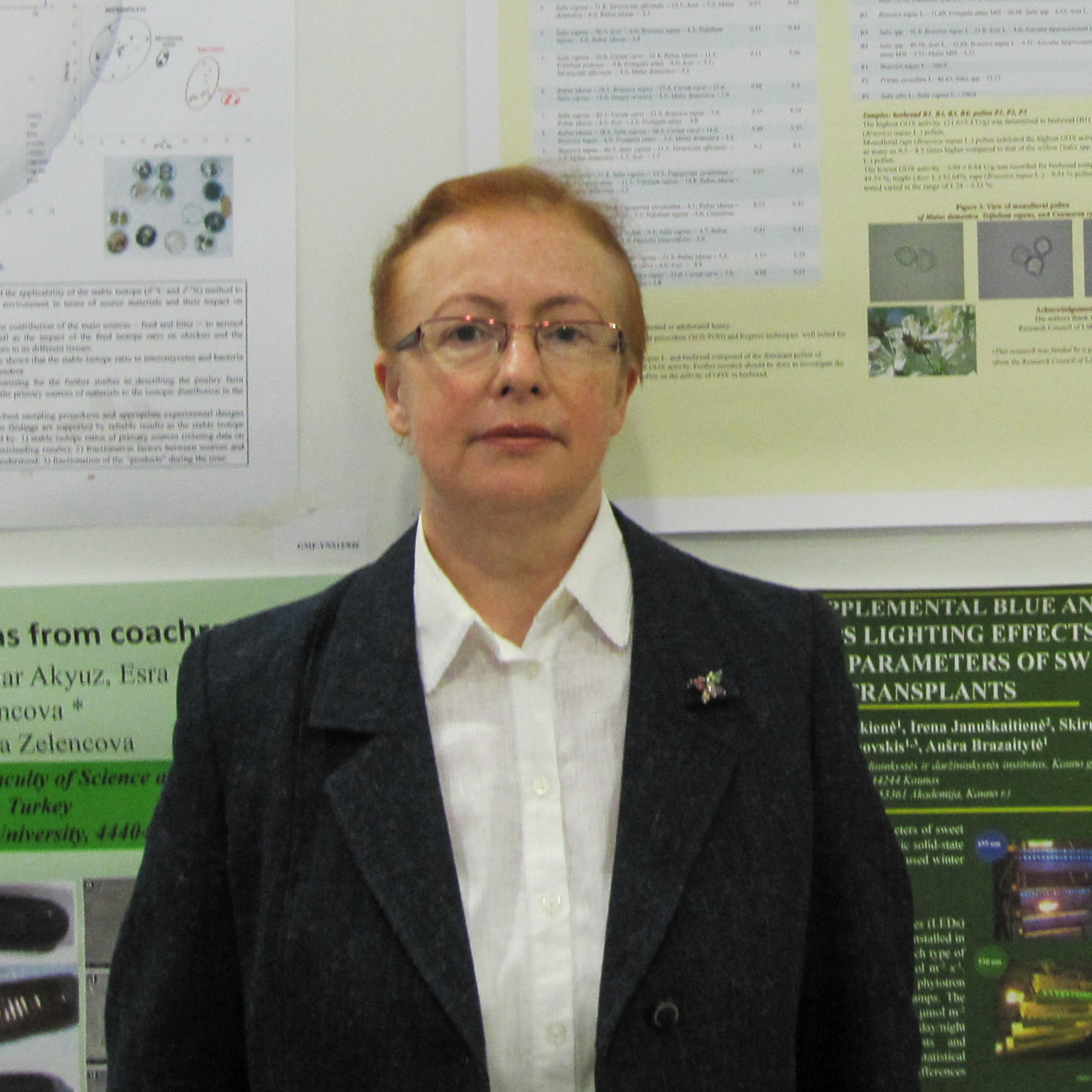 ORCiD iD: 0000-0002-5569-0470
ORCiD iD: 0000-0002-5569-0470
Mob. +370 672 52 128
E-mail: violeta.ceksteryte@lammc.lt
Stoties g. 2, Akademija, LT-58344 Kėdainiai dist., Lithuania
Education
1971–1976 bachelor degree in inorganic materials technology, Faculty of Chemical Technology, Kaunas Polytechnic Institute (since 1990 Kaunas University of Technology).
Academic degree
2012 Doctor of Agronomy Science, dissertation “Methods for preserving pollen and storage conditions”.
Research fields
- Biochemical properties of bee products
- Honey and pollen application possibilities to improve human health research
- Bee pollen proteomic studies
Position
Since 1997 Senior Researcher, Institute of Agriculture (until 2010, Lithuanian Institute of Agriculture), LAMMC
Memberships and affiliation with professional organisations
- Member of the Lithuanian Apitherapy Association
- Member of the Lithuanian Beekeepers Association
Involvement in programmes and projects
- 2021 Ministry of Agriculture of the Republic of Lithuania, project “Comparison of protein composition of mixed aphid and nectar - honydew honey with monofloral clover nectar honey”, leader.
- 2020 Ministry of Agriculture of the Republic of Lithuania, project “Identification of the diversity of proteins in honeydew honey”, leader.
- 2017, 2018, 2019 Ministry of Agriculture of the Republic of Lithuania, projects “The study of the useful properties of Apis mellifera carnica bee lines, and evaluation, preservation of the gene pool”, leader.
- 2018, 2019 Ministry of Agriculture of the Republic of Lithuania, project “Study of using possibility of organic products Api Life Var and Api-Bioxal for the treatment of Varroa mites and evaluation of their efficiency”, leader.
- 2016–2018 Ministry of Agriculture of the Republic of Lithuania, project “Qualification and quantification of pollen, extracted from honey and their correlation with the flight distance of the honey bee”, implementer.
- 2017 Ministry of Agriculture of the Republic of Lithuania, project “Evaluation of proteins of pollen extracted from honey and collected manually and plant preference by bees”, implementer.
- 2017 Ministry of Agriculture of the Republic of Lithuania, project “The effectiveness of the APIVAR and MAQs preparations in killing varroa mites and the study of the effects on bee colonies”, implementer.
- 2016 Ministry of Agriculture of the Republic of Lithuania, project “Determination β-/γ amylase in honey and in bee food for the winter, leader.
- 2012–2015 The program “Healthy and safe food” project “Investigation of composition and properties of bee products enriched with vegetable components”, the project was implemented with the Biochemistry Institute of Vilnius University , implementer.
- 2015 Ministry of Agriculture of the Republic of Lithuania, project “Comparative changes in the properties of honey after it's extraction using a cascade-heating strainer for filtration”, leader.
- 2013 Ministry of Agriculture of the Republic of Lithuania, project “The effect of fresh bee bread mixed with honey, on eye blood flow in myopic patients”, coordinator and implementer. Jankauskienė J. implementer from Lithuanian University of Health Science (LSMU).
- 2013 Ministry of Agriculture of the Republic of Lithuania, project “Strengthening of universities' knowledge and technology transfer capabilities” (UniGeb). Project “Unification and dissemination of knowledge about earth and forest science research and technology”, methodology expert.
- 2009 Ministry of Agriculture of the Republic of Lithuania, project “Contamination of bee products of various botanical origins with heavy metals and pesticide residues”, implementer.
- 2008, 2009 Ministry of Agriculture of the Republic of Lithuania, project “Investigation of the effects of thermal and mechanical treatment of honey on its quality and choosing of optimal parameters”, implementer.
- 2008–2009 Ministry of Agriculture of the Republic of Lithuania, project “Bee products used for improving human health”, coordinator and implementer. Project implementers J. Jankauskienė and A. Baltuškevičius from Lithuanian University of Health Science (LSMU).
- 2007–2013 EU project “University Knowledge and Technology Transfer Capability Intensification” (UniGeb), expert in methodology.
- 2006 Ministry of Agriculture of the Republic of Lithuania, project “Genetic diversity of different bee races”, coordinator and implementer.
- 2004 Ministry of Agriculture of the Republic of Lithuania, project “Analytical methods for determining the composition of honey”, leader, coordinator and implementer (prepared methodologies, harmonized on the approval of the project and methodologies).
- 1997 Ministry of Agriculture of the Republic of Lithuania, project “Prepared standard for honey research Honey (technical conditions)” LST 1466:1997 (during project implementation the translation of the methodologies was performed, agreed on the validation of the methodologies).
SCIENTIFIC PUBLICATIONS (click the link here)
 ORCiD iD: 0000-0002-5569-0470
ORCiD iD: 0000-0002-5569-0470